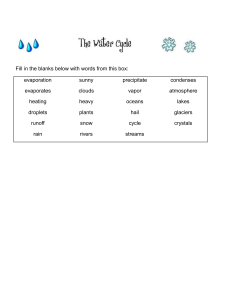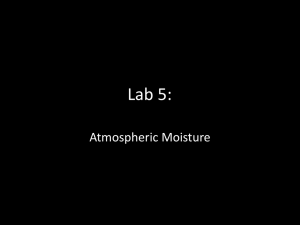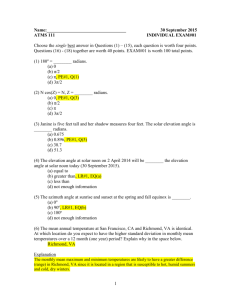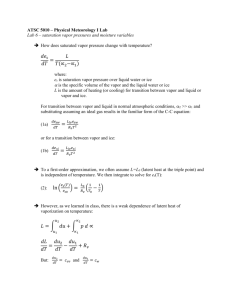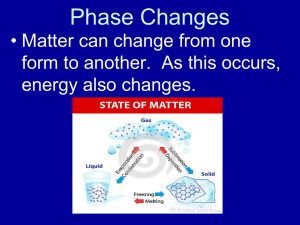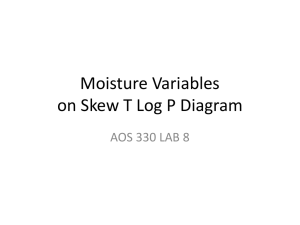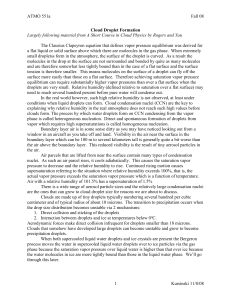Exam#2
advertisement
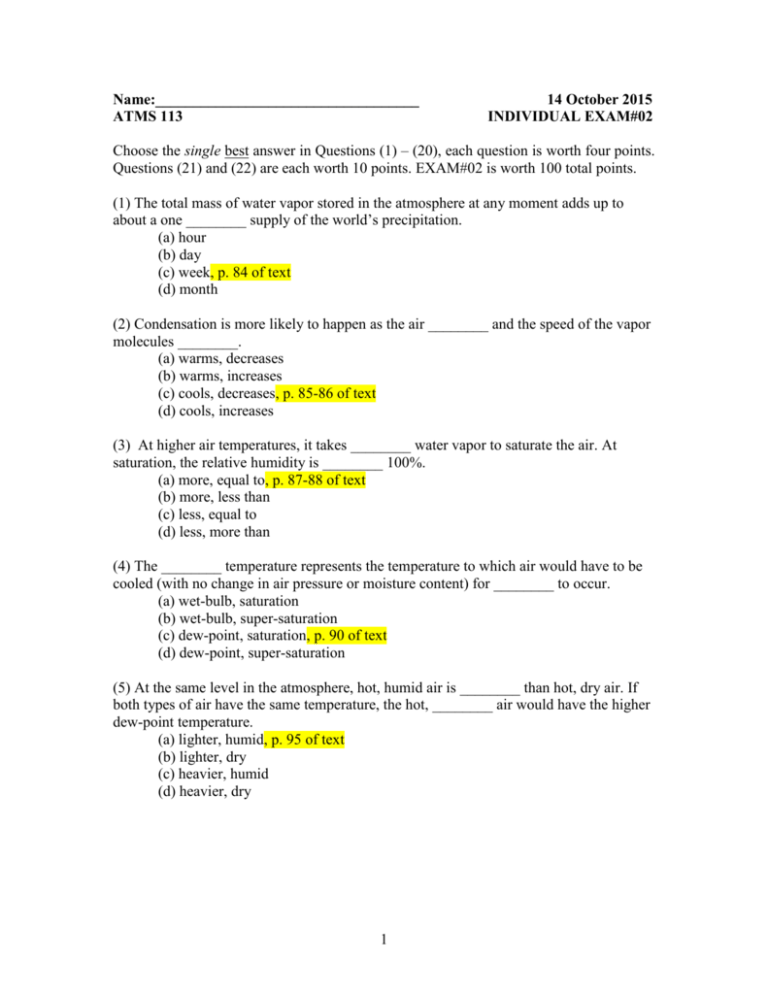
Name:___________________________________ ATMS 113 14 October 2015 INDIVIDUAL EXAM#02 Choose the single best answer in Questions (1) – (20), each question is worth four points. Questions (21) and (22) are each worth 10 points. EXAM#02 is worth 100 total points. (1) The total mass of water vapor stored in the atmosphere at any moment adds up to about a one ________ supply of the world’s precipitation. (a) hour (b) day (c) week, p. 84 of text (d) month (2) Condensation is more likely to happen as the air ________ and the speed of the vapor molecules ________. (a) warms, decreases (b) warms, increases (c) cools, decreases, p. 85-86 of text (d) cools, increases (3) At higher air temperatures, it takes ________ water vapor to saturate the air. At saturation, the relative humidity is ________ 100%. (a) more, equal to, p. 87-88 of text (b) more, less than (c) less, equal to (d) less, more than (4) The ________ temperature represents the temperature to which air would have to be cooled (with no change in air pressure or moisture content) for ________ to occur. (a) wet-bulb, saturation (b) wet-bulb, super-saturation (c) dew-point, saturation, p. 90 of text (d) dew-point, super-saturation (5) At the same level in the atmosphere, hot, humid air is ________ than hot, dry air. If both types of air have the same temperature, the hot, ________ air would have the higher dew-point temperature. (a) lighter, humid, p. 95 of text (b) lighter, dry (c) heavier, humid (d) heavier, dry 1 Name:___________________________________ ATMS 113 14 October 2015 INDIVIDUAL EXAM#02 (6) Dew is more likely to form on nights that are ________ and forms when water vapor begins to ________ on cold surfaces. (a) clear and calm, evaporate (b) clear and calm, condense, p. 96-97 of text (c) cloudy and windy, evaporate (d) cloudy and windy, condense (7) Fog produced by the earth’s radiational cooling is called ________ fog. (a) advection (b) ground, p. 97 of text (c) upslope (d) evaporation (mixing) (8) As an air parcel rises, it expands and ________. If the air parcel is unsaturated (subsaturated), the rate of ________ remains constant and is about ________ degrees Celsius for every 1000 meters of change in elevation. (a) warms, warming, 6 (b) warms, warming, 10 (c) cools, cooling, 6 (d) cools, cooling, 10, p. 118-119 of text (9) Which of the following mechanisms does not stabilize the atmosphere? (a) an influx of cold surface air brought in by the wind (b) air moving over a cold surface (c) an influx of cold air aloft brought in by the wind, p. 120 of text (d) nighttime radiational cooling of the surface T (oC) 12 11 10 Z (km) 3 2 1 0 (10) A weather balloon sounding is taken at the UNCA campus and the environmental temperature at four different elevations is given in the table above. The environment at the time of this sounding is ________. (a) absolutely stable, p. 119-120 of text (b) absolutely unstable (c) conditionally unstable (d) not enough information is given (11) Which of the following mechanisms is not responsible for cloud development? (a) uplift along weather fronts (b) air parcels undergoing adiabatic compression, p. 124 of text (c) surface heating and free convection (d) uplift along topography 2 Name:___________________________________ ATMS 113 14 October 2015 INDIVIDUAL EXAM#02 (12) The ________ process plays a significant role in producing ________ when a cloud is made up primarily of liquid water droplets. (a) Bergeron, precipitation (b) Bergeron, condensation nuclei (c) collision-coalescence, precipitation, p. 128-130 of text (d) collision-coalescence, condensation nuclei (13) The saturation vapor pressure just above ________ surface is greater than the saturation vapor pressure just above ________ surface, hence, ________ grow at the expense of surrounding ________. (a) an ice, a liquid water, ice crystals water droplets (b) an ice, a liquid water, water droplets, ice crystals (c) a liquid water, an ice, ice crystals, water droplets, p. 131 of text (d) a liquid water, an ice, water droplets, ice crystals (14) If a snowflake melts as it is falling, changing into a raindrop, it will most likely fall as ________ at the ground if it falls through a deep subfreezing surface layer of air. (a) hail (b) sleet, p. 138-139 of text (c) freezing rain (d) snow (15) The surface pressure is identical at Station A and B shown above. The air inside the atmospheric column above A is ________ than the air above B, while the air pressure aloft above A is________ than the air pressure aloft above B. (a) warmer, lower (b) warmer, higher, p. 150-152 of text (c) colder, lower (d) colder, higher (16) ________ corrections to surface pressure are normally adjusted to mean sea level. The sea level pressure at Asheville, NC is always ________ than its station pressure. (a) Altitude, greater, p. 154-156 of text (b) Altitude, less (c) Temperature, greater (d) Temperature, less 3 Name:___________________________________ ATMS 113 14 October 2015 INDIVIDUAL EXAM#02 (17) Which of the following forces plays a very minor role in determining the wind speed and direction far above the earth’s surface? (a) pressure gradient force (b) Coriolis force (c) centripetal force (d) friction, p. 162-165 of text (18) The ________ force causes the wind to deflect to the ________ of its intended path in the Northern Hemisphere. (a) Coriolis, right, p. 160-162 of text (b) Coriolis, left (c) centripetal, right (d) centripetal, left (19) The winds aloft in the mid-latitudes generally blow from the ________ since high heights (or pressure) are generally found to the ________. (a) west, south, p. 164-165 of text (b) west, north (c) east, south (d) east, north (20) Air doesn’t rush off into space because the upward-directed ________ force is nearly always exactly balanced by the downward force of gravity, a condition known as ________ equilibrium. (a) Coriolis, geostrophic (b) Coriolis, hydrostatic (c) pressure gradient, geostrophic (d) pressure gradient, hydrostatic, p. 168-169 of text 4 Name:___________________________________ ATMS 113 14 October 2015 INDIVIDUAL EXAM#02 (21) 10 points The chart above shows the air temperature (dashed) and relative humidity (solid) trace on a day in Asheville when the air’s water vapor content remains constant throughout the day. Explain the fluctuation in the relative humidity trace. p. 87 – 89 of text Relative Humidity (RH) = [ (actual vapor pressure) / (saturation vapor pressure) ] x 100% Two ways of changing RH: [1] change the air’s water vapor content [2] change the air temperature (change its saturation vapor pressure) Method [1] is not contributing on this day because the air’s water vapor content remains constant throughout the day. Saturation vapor pressure is a function of air temperature; the warmer the air temperature, the higher the saturation vapor pressure [see Fig 4.5]. On this day, RH is inversely related to air temperature; RH is a maximum (minimum) when air temperature is a minimum (maximum). 5 Name:___________________________________ ATMS 113 14 October 2015 INDIVIDUAL EXAM#02 (22) 10 points The isoheights (lines of constant height) for an upper-level 500 mb map are straight and the wind (arrow) has a speed that is constant (no acceleration) as depicted on the map above for a region located in the Northern Hemisphere. [1] Circle the most likely type of wind shown in the figure. (a) gradient wind (b) geostrophic wind, p. 162 of text (c) neither [2] Label (with an “L”) where you would expect to find the lower pressure (or heights). [3] Draw and label arrows indicating the proper direction and type of forces for the most likely type of wind shown in the figure. Use all, some, or none of the following labels to define the forces corresponding to your arrows: “PGF” = pressure gradient force, “CoF” = Coriolis force, “CeF” = centripetal force, and/or “Fr” = friction. geostrophic wind blows in the Northern Hemisphere with lower pressure to its left and higher pressure to its right. The PGF and CoF are the only “players” in the situation of geostrophic flow, with the CoF arrow always directed to the right of the flow direction in the Northern Hemisphere (see p. 162-163 of text) 6



